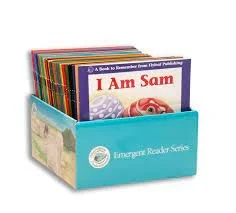When Do I Use Decodable Texts?
Are you confused about when to use decodable texts and when to use leveled texts? Don’t worry, I was confused too….and to be honest, with all the talk about the Science of Reading, it is hard to decide where to start. Sometimes when we are inundated with too much information, the overwhelm kicks in.
Today I want to break down decodable texts for you, why they are important, and when we should use them. My hope is that I will clear up any lingering questions you still have and get you back on track.
Before we start, we must first understand the difference between a leveled text and a decodable text.
Leveled Texts are books that are categorized by level of difficulty. Some books are leveled by letters (levels A-Z) and some are leveled by numbers (1-70). As teachers and specialist, we use these diagnostic assessment tools to help determine three reading levels.
Independent- The child is able to read the book effortlessly with proper fluency, retell and respond the questions about the book (comprehension). Students usually score between 96-100% accuracy in the areas of comprehension and fluency to be considered independent at this level.
Instructional- The child is able to read the book with minimal errors with proper fluency, retell and respond the questions about the book (comprehension). Students usually score between 90-95% accuracy in the areas of comprehension and fluency to be considered instructional at this level. This is ideally the level that we start instruction for our students.
Frustration-The child is unable to read the book effortlessly with proper fluency. The child may also struggle retell and respond the questions about the book (comprehension). This is usually due to the fact that they are spending so much time decoding and they are unable to comprehend what they are reading. Students usually score below 90% accuracy in the areas of comprehension and fluency to be considered frustration at this level.
Decodable texts are words, sentences, books, or passages that are written with a focus on particular phonetic patterns. Each book is designed to accompany the phonics skills you are already teaching. Decodables help students apply the phonics skills they are working on. Most decodable focus on the phonics patterns of short vowels, long vowels, and vowel teams.
Goals for each stage
Now that we understand what leveled texts and decodable texts are, let’s take a look at the GOALS for each stage of our readers.
Emergent: The goal of an emergent reader is to understand phonological awareness concepts and be able to rapidly name letter sounds.
Beginner: The goal of a beginning reader is to take the knowledge that they learned in the previous stage and apply it to print. These students need LOTS and LOTS of phonics and decoding practice to become fluent. We also want these students to start recognizing words by sight through orthographic mapping.
Transitional: The goal of a transitional reader is fluency. We want these kiddos to have automatic word recognition and to begin making the switch to comprehension.
Instructional: The ultimate goal is for all of our students to become instructional readers. We want their reading to be effortless. We want to them to read for understanding. The goal of an instructional read is language comprehension.
**I feel like it is important to note that as teachers, we may have a wide range of these students in our classrooms. Meaning, a third grade teacher may have students at the emergent level and a first grade teacher may have students at the instructional level. For those teachers in grades 3-5 who have emergent and beginning readers in their classrooms, it will be crucial that we focus on their area of need.
Alas, this brings me to the question, you have all been wondering. When do we use decodable texts and when do we use leveled texts.
I would like to draw your attention to the beginning reader goals.
When student are learning to read, it is important to provide them with support in decoding. This means that they should practice the phonics skill in isolation, and then follow it with a decodable. This is how are students make the connection.
Sometimes, giving students and entire decodable passage can be overwhelming. If you notice this, take a deep breath and follow these easy steps.
Practice decoding words in isolation
Move to decoding words at the sentence level with support.
Continue reading at the sentence level but remove some support
Move into decodable books or passages
Students who are working to decode one syllable words, should be using and reading decodable texts. Our ultimate goal is to build that sight recognition. We can only do that through lots and lots of phonics practice, followed by lots and lots of practice in context. Once your students are able to decode these patterns with ease, it is time to move them into leveled texts.
I know the question circling around in your head is… How the heck do I teach comprehension to these kiddos? Don’t worry, I can help with that too.
When students are focusing on learning to decode, we should pull in comprehension and vocabulary through our daily read aloud. Students can be practicing their comprehension skills by participating in these read aloud and the discussions that happen because of them.
I hope this post help to clear up any lingering questions you have about decodable texts. If not, please don’t hesitate to send me a message. I would love to talk more with you!
Below you will find some of my favorite decodable resources.







